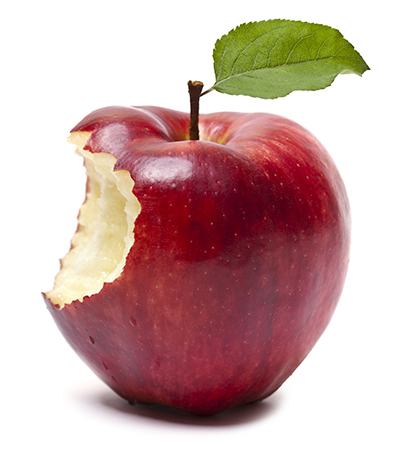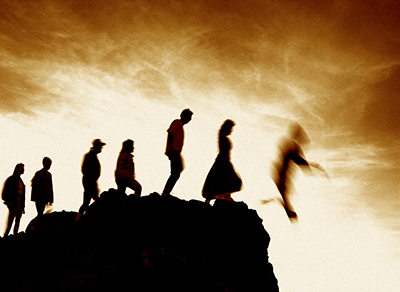
|
In the Bible, in Genesis 2:16-17, the Lord God warns Adam and Eve against eating the apple from the Tree of the Knowledge of Good and Evil. They do so anyway, because the Serpent—Satan in disguise—tempts Eve with flattery. And after she eats, she entices Adam to join her. This act is the one thing in all of their idyllic existence that God has forbidden them to do. It is the one fruit in the Garden, a place of plenty and pleasure, that is denied to them. And when they eat it, they are banished forever into a hard and desolate world to make their way amid toil and suffering.
For Christians and Jews, this is the “original sin.” It is the moment of mankind’s “fall from grace” and separation from God. This one ancient act removes all of us—even the most innocent, the newborn babies, the harmless imbeciles, and saints who strive to do good and create love and understanding all their lives—from God’s perfect love and understanding. This knowledge of good and evil is also, by the way, the major functional capability that separates us from the animals. This is what makes us human.
The wolf hunts the rabbit and eats it. The wolf is not mean-spirited or bad-tempered. The wolf does not hunt the rabbit because the wolf is evil. The wolf also knows nothing of love and mercy. It cannot refrain from hunting out of compassion for the rabbit’s meek little life. So the wolf also cannot become good in any moral sense. The wolf is merely fulfilling its nature as decreed by evolution or, if you will, as designed by God. The wolf does what it needs to survive in its environmental niche. If the wolf knows anything about good and evil, it is a simple equation: hunt and eat equals good; fail and starve equals bad. The wolf cannot even try to be good or sink to being bad. It can only be effective or ineffective in its ultimate purpose, which is hunting and eating rabbits and other small mammals.
Human beings have reasoning power. We also have refined emotional states. We can, we do, and we must think and feel about what we are doing. This is the cap that the prefrontal lobe—the center of the brain’s analytical, planning, directing, and decision-making capabilities—puts on our motor functions and our biological, endocrinological urges. We cannot help but think about ourselves and our actions—and ask questions about them. The content of those questions are not so much biologically based or inherited as they are culturally transmitted. For human beings are cultural and social beings, no matter whether we were developed that way by evolution or designed that way by God.
In one case, if your parents and your society laid emphasis on right and wrong, good and bad, you will likely ask if what you are doing or intending to do is moral or immoral in that context. But if your parents and society only laid emphasis on utility and efficiency,1 you would probably only ask if what you were doing or planning was going to work or not, to succeed or fail in your own interest, with less regard with whether you ought to do it or how it might affect others. But you would still ask yourself questions. You would still apply values, although biology and evolution cannot tell you what those values should be.
But later in the Bible story, in Genesis 3:22, God reveals his true purpose in denying humanity the apple. By knowing good and evil, Adam and Eve have become “as one of us”—that is, like God Himself and the higher order of angels. The human pair must be banished from the garden before they also eat from the Tree of Life and become immortal. Immortality plus ethical judgment apparently equals status as a rival godhead.
So the sin was not just disobedience—crossing a line that God had drawn around a certain tree in the garden. There are other sins of disobedience that humans have since repeatedly committed—particularly those carved in stone by the Moving Finger: taking other gods, worshipping idols, abusing the holy name, breaking the sabbath, disrespecting parents (the sins against reverence), as well as murder, adultery, theft, perjury, and envy (the sins against other people and property). None of these sins will damn a person or a race of beings for all time. And none is so grievous that it cannot be forgiven.
But the sin with the apple, coupled with the potential for sinning with the Tree of Life, was the one that could not be forgiven, ever. It comprised these two first humans—creations of the Lord God—aspiring, whether knowingly or not, to become gods themselves. In doing so, Adam and Eve broke up the order of things. They stepped above their proper place. They were set to become uppity.
This sort of thinking, that human beings were supposed to fit into a divine order and had to know their place, smacks of the medieval faith in what was once called the “Great Chain of Being,” or in Latin, Scala Naturae, the “Ladder of Being.” It’s an idea that goes back to the Greeks, with Aristotle and Plato. In this hierarchy, all of creation fits into a stepwise progression from inanimate matter, to plants, to animals, to human beings as a special and favored kind of animal, to angels, to God himself.2 This was the way of the world. This was the fixed order of creation.
Stepping outside this order would tend to challenge and subvert the notion of Creation itself. In a theology that depends on a Creator God, and places that God at the apex of all things inanimate and animate—in the old sense of having an animus, or life-giving spirit—the created being cannot rise above the creator. Cause and effect just don’t work that way.
But in the world in which we actually find ourselves—and putting aside cultural myths and creation stories3—the top of this world’s hierarchical existence is human-scale intelligence. Other animals may be larger, stronger, or faster. Some may even have intelligence approaching our own—like dolphins, whales, and elephants. But none of them has yet invented writing, or calculus, harnessed fire, or sent radio waves above the atmosphere. And that’s not for the lack of opposable thumbs—or the fact that dolphins and whales live in the sea, without access to fire and electricity—but the lack of understanding, planning, and imagination.
We human beings did not create ourselves, or not in the original biological form. That form with its massive brain evolved from the primates, who go back to ancestors among the apes, and from there back to the mammals, reptiles, amphibians, fish, etc. We did not do a whole lot of self-inventing for the hundred thousand years or so during which we hunted the slower animals, gathered the most edible berries, and experimented with fire when we found it resulting from a lightning strike. But once we settled down in the richest river valleys, discovered agriculture, and invented writing, our days as simply clever animals were over. We invented ourselves by capturing the thoughts of other people and previous generations and committing them to stone, clay, and papyrus in forms that people who had never met the original thinkers could interpret and understand. And from there, we went on to invent culture, science, and—yes—even religion, hierarchies, and notions of “divine right.”
Aside from our meaty parts, which evolution gave us, we are the animal that invented itself. We worked out notions of right and wrong, good and evil, utility and efficiency, and all the other values which we conjure and apply to the universe around us. We worked them out from observation, shared experience, and transmitted culture. Although still Homo sapiens in physical form, we are no longer our primitive, stone-chipping, berry-picking ancestors, any more than we are still H. neanderthalensis or A. afarensis. We have continued evolving in our minds, our culture, and our understanding.
We are the closest thing to gods as exist on this planet. And that will have to do until the Saucer People show up and can teach us something new.
1. You can imagine a society composed mainly of scientists and engineers—say, the Bene Tleilax of the Dune universe—who would place efficacy and utility as values above kindness and compassion. Their world might be mechanically perfect, but still it would be a hard place to live.
2. I suppose subdivisions are possible in this hierarchy, too. For example, a horse, for its general utility and gentle nature, would be ranked higher than the wild ass or zebra. And the more useful cow would outrank the moose and deer. If the Greeks and medieval Christians had known about protozoa, microbes, and germs, they would probably have classed them somewhere between dirt and plants, down there with the corals and sponges. It’s a game scholars can play endlessly.
3. And yes, I know: in this case, the Theory of Evolution and its great chain of ancestors, from the first self-replicating molecules, to RNA, to DNA, through the Cambrian explosion, to the armored fishes, the lobe-finned fishes, tetrapod amphibians, reptiles, and finally mammals to human beings, is just another creation story, revered with semi-mystical status.



